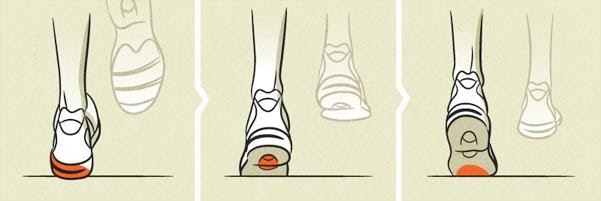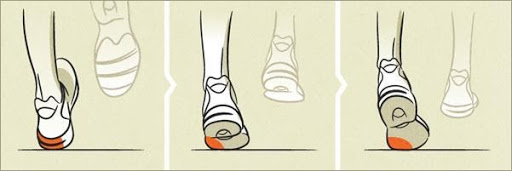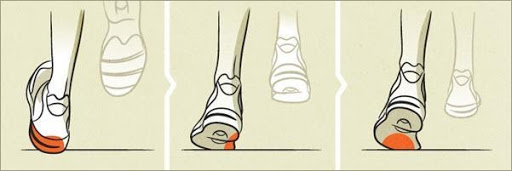Pronation is part of the natural movement that helps the lower leg deal with shock. Everyone has it to some degree, and it is a good thing!
Pronation describes the way the foot rolls inward when you walk and run. Some runners will pronate more (i.e. they overpronate) or less (underpronate) than others. Though this is not bad in itself, it does affect the way you run and it may increase the likelihood of injury. This makes your pronation pattern a vital factor in choosing the right running shoes.
When you walk or run, pronation helps to negate the shock of initial contact. Without it, the full impact of each step would be transmitted up the leg and affect the normal mechanics of the lower limbs. Besides acting as a shock absorber, pronation also helps the foot ‘recognise’ what type of ground it is on by stabilising and adjusting the foot to the terrain type.
Neutral/Natural Pronation
You are likely to be a neutral pronator if the soles of your shoes show wear in an S-shaped pattern, from the outer (lateral) heel to the big toe. When you have a normal pronation pattern you can run in a wide variety of shoes, but specialised neutral running shoes offering cushioning and support are most suitable neutral shoes.

Underpronation (high arch foot)
Underpronation, also known as supination, is when the foot hardly pronates. The outer or lateral side of the heel hits the ground at an increased angle, and little or no normal pronation occurs, resulting in a large transmission of shock through the lower leg. Underpronators (or supinators) are likely to have excessive wear on the outer heel of their shoes, and the upper part of the shoe may be pushed over to the lateral side.

Underpronators are more likely to be susceptible to shock-related injuries like stress fractures, and therefore should choose a neutral running shoe with plenty of cushioning. The extra cushioning will lessen the impact of landing the legs have to endure when running.
Overpronation (flat foot)
Generally speaking, a runner that over-pronates will have a foot that strikes on the outside of the heel (like it should), but then rolls inward excessively. The associated foot type has a low/flat arch and usually does not have enough stability. But don’t worry too much if you fall into the over-pronation category… you are in good company as 70% of all runners will over-pronate to some extent. Normally, running with over-pronation won’t cause you adverse problems just as long as you select the right trainer.
The process of over-pronation can be more fully explained as follows: Too much weight is transferred to the inner or medial side of the foot, and as the runner moves forward the load is borne by the inner edge rather than the ball of the foot. This destabilises the foot, which will attempt to regain stability by compensating for the inward movement. In a kind of chain reaction, this in turn affects the biomechanical efficiency of the leg, especially the knee and hip.

Generally, runners who over-pronate should consider choosing stability shoes, which provide a degree of stability and cushioning stability shoes, Running shoes in this category will help your feet distribute the impact of running more effectively.